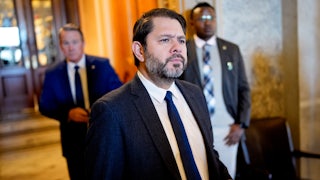After declaring a state of emergency around this time last year, Mississippi Governor Tate Reeves announced his intent to halt all surgical abortions in the state. “We’re doing everything in our power, and have for many years, to make Mississippi the safest place in America for unborn children,” said Reeves, who was far from alone in his pursuit. In the early months of the pandemic, Republican lawmakers in 11 other states would also attempt to litigate abortions as “nonessential.”
None of these attempts were successful. Pointing out the obvious, some federal judges argued they would cause “irreparable harm” to those in need. Even so, Republican legislators continued to churn out abortion restrictions with tedious fervor. “Heartbeat bills,” which prohibit abortions after the first fetal heartbeat is detected, found new footing in South Carolina. As people turned to telemedicine in order to safely procure abortion medication during the pandemic, Republican lawmakers seethed, an ire that the Supreme Court validated in January when the new conservative majority ruled to reinstate a federal requirement that abortion medication be picked up in person, adding further injury to the challenges—stretching over tens of miles—people face in accessing abortions. In the year since the coronavirus took hold of the country, 384 abortion restrictions have been introduced nationally, Elizabeth Nash, the lead state analyst at the Guttmacher Institute, told me.
Much of this proposed legislation is not plausibly constitutional. Consider a bill proposed in Arizona that would convict people who provide and people who receive abortions with homicide charges, or the bill in Tennessee that would allow “fathers,” even if not genetically proven, to stop their partner’s abortion. “The will to make abortion illegal is not only outsized,” Kimberly Mutcherson, professor and co-dean of Rutgers Law School, explained to me, “but it’s frankly a cornerstone of the Republican Party.” Since Ruth Bader Ginsburg’s death in September, the goal of these lawmakers has been to “pass these laws that are blatantly unconstitutional until they can get up to the Supreme Court,” for the sake of affecting anti-abortion laws on a federal level. As one lawmaker in Montana said: “If this legislation made it all the way to the Supreme Court, that would be a good thing, because we need to revisit Roe v. Wade.”
The question beneath this all is one of comprehension: How can anyone make sense of the continuing political will to criminalize abortions? This will, which has been cushioned firmly in the Republican Party and on the right for decades, takes a more sinister shape against the backdrop of an unprecedented public health crisis. It translates to a cruelty that is as unceasing as it is casual—and the constituents bear the expense.
The immediate consequences of this cruelty were exceedingly clear last year in Texas, where the attempted “nonessential” ban pushed by Governor Gregg Abbott and Attorney General Ken Paxton left abortion clinics in the blue for months. According to a recent analysis, Texas abortion clinics reported a decrease in abortions under the ban; after the ban was lifted in late April, clinics reported an 83 percent increase in later-stage abortions. A study by researchers at Texas A&M calculates that delaying an abortion, as mandatory waiting periods already do, can increase the monetary cost of obtaining the abortion by nearly $1,000. The further one is into the pregnancy, the more expensive an abortion can be. This was a reality Texans had no choice but to confront, standing as a stark reminder that restrictive laws do not restrict universally; they restrict only those who cannot afford to bypass them.
This results in a “vicious cycle,” said Bridget Schilling, a board member at an abortion fund in Houston called the Clinic Access Support Network. Schilling described the housing and unemployment crises caused by the pandemic in Houston as “catalysts” for this unjust cycle. In Houston, the unemployment rate has nearly doubled since the onset of the pandemic; Houston is also one of the leading cities nationwide in terms of eviction filing numbers. Even with a moratorium on evictions, people have still slipped through the cracks. For many, including those served by Schilling’s fund, the cost of an abortion has become just one of many costs accumulated during this time of crisis: “That can mean unemployment, plus trying to provide rent, plus childcare, because the majority of the people we serve have a child or are already parenting,” Schilling said. It is impossible to disentangle the current crisis in accessing reproductive health care from the economic crisis born of the failed political response to the pandemic.
And both will have a long tail. The economic consequences alone of not being able to receive an abortion are severe enough to last a lifetime. Using data from the five-year, longitudinal Turnaway Study, a recent working paper for the National Bureau of Economic Research found that being denied an abortion significantly increased overdue debt and “negative public records,” such as bankruptcies and evictions. Diana Greene Foster, the lead researcher on the Turnaway Study, detailed a similarly harrowing portrait of the consequences women who are denied abortions suffer in a 2018 opinion piece for the Los Angeles Times: a loss in full-time employment; increased dependence on public assistance; increased household poverty; a greater likelihood that women won’t have enough money to pay for food, housing, and transportation; and, finally, an increased chance that women are raising children alone. Not being able to receive an abortion, Greene wrote strikingly, “makes poor women poorer.”
This pandemic did much of the same—calcifying hardship for millions who were already struggling, leaving them, for nearly a full year without relief, with even less. These are consequences that self-described “pro-life” lawmakers do not concern themselves over.
In the pandemic, it has been the people—not the politicians—who have continued to push for reproductive justice. Abortion funds date to the late 1990s, when a handful of grassroots efforts united to form the National Network of Abortion Funds, which today stands vibrantly as an umbrella organization for abortion funds across the nation. These funds go beyond the mere purpose of financial support for abortions. Schilling’s fund, for instance, focuses on practical support, “which means, essentially, all the services that it takes to actually get somebody to their abortion, outside of paying for it.” The Clinic Access Support Network, according to Schilling, is the largest provider of practical support in the country. Thanks to its large volunteer base, the fund has been able to cover “over 1,000” rides to abortion clinics a year.
The 10 abortion funds in Texas are tight-knit. If one fund isn’t able to support a caller, described Zaena Zamora, executive director of the Frontera Fund in the Rio Grande Valley area of Texas, then another fund will take up the effort to help. This situation is different in North and South Carolina, where there is only one fund, the Carolina Abortion Fund. This places an inherent pressure on the fund that has only worsened during the pandemic. “We’re stretched thin financially,” Mars Earle, the director of engagement for the Carolina Abortion Fund, told me.
The “financial trauma” inflicted by the pandemic upon the fund’s primarily lower-income and uninsured callers has resulted in higher monthly expenditures. Earle described that, recently, the fund has interacted with many callers struggling with financial insecurity. “We’re seeing people who not only may not have been able to afford, say, a sudden $300-plus cost that you have to pay upfront but are also behind on utilities or other things.” Even after an executive board decision to push the fund’s budget and increase monthly costs, Earle estimates the Carolina Abortion Fund has only been able to serve “a third to a half” of callers in the past six months.
This situation is not exclusive to this fund. Abortion funds rely on donations, and even with as much outpouring and support as they receive, it never seems to be enough to meet caller demand. In the fiscal year of 2020, member funds in the National Network of Abortion Funds have only been able to support 56 percent of callers, the organization told me. That 56 percent amounts to 52,000 callers and over $9.28 million on abortion funding and practical support. This is still a more positive number than the prior fiscal year, during which NNAF funds were only able to support 26 percent of callers. It’s clear the support is great, but the need is greater.
But in a testament of strength, the Carolina Abortion Fund’s work has still managed to deepen in the last 12 months. As a result of the pandemic, CAF has been strategizing to work more closely with neighbors and local mutual aid organizations. The focus has to address their callers’ needs for the abortion, while also offering more holistic care. “You might need groceries afterwards, or need to make sure your light bulbs are still on,” Earle said. As for Zamora, the challenge of leading an abortion fund through a pandemic has actually proved reaffirming. Despite the spike in caller demand at the outset of the pandemic, Zamora’s fund has grown significantly. “We got a lot of other donations from people who might not have thought about us [before the pandemic].… But they saw what the governor and state legislature were trying to do … and it made people realize the importance of the funds.”
Where our lawmakers have exploited the pandemic as an opportunity to criminalize, others have maintained incredible resilience in the fight for reproductive justice. What abortion funds and others demonstrate is a certain conviction to continue believing, even during one of the most dire times in history, that collective work can pave the way to a future in which everyone has the access to make reproductive decisions for themselves. And as we lift ourselves out of the pandemic after this long year, we must hold tightly to the vision made possible by abortion funds: that we deserve to exist in a world in which everyone, regardless of who they might be, can determine themselves freely. This work will be difficult, but it is ours—and as this year has shown, it is still as urgent as ever.








